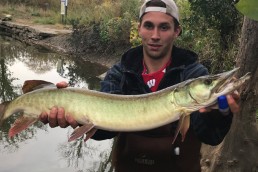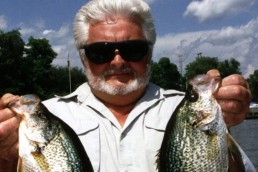Taking Photos of Your Catch
SHARE THIS POST
There are many schools of thought out there ranging from not taking the trout out of the water to laying it on the ground or net. Then there are no photos at all to consider. I’ve struggled with this throughout the years, as fishing solo can create a lot of problems.
A trout has a protective slime coating that can be wiped or rubbed off by many ways. One of the more common methods is to let it lie on the ground or even the snow for a photo. This is really bad on the trout. You’re too busy trying to focus your camera with a wet and slippery hand while your photo subject is flopping around and dying from lack of oxygen. The fish is also likely rubbing off its slime coat on the net or the ground in this case.
You really have a dilemma here, and now I’ve eliminated the ground or net from my standard operating procedures for a picture. That fish is going to die using the above method. It’s simply better to take quality photos and not place your caught trout in peril.
The first thing I do is to unhook the trout in the net on the edge of the stream if I’m on near a bank. Your net choice now becomes a huge factor. The trend today is going with the ghost-type bags, but these are not deep enough for my liking. I use a knotted-type net with a very deep non-tapered bag. The non-taper is the key, as a trout can feel secure in a bigger bag and not thrash around, causing its slime layer to be affected. My net has a sizable opening too and a longer handle.
There are two ways I use my net to my advantage. After I net a fish and unhook it, I’ll leave the trout in the water. The longer handle can be very convenient for this. Place the net handle between your knees and leave the trout submerged in your deep bag. You can then reach into your pocket and get to the camera without the trout in hand. You can then reach in the net bag and wet your hand as you do so, lifting the trout out of the water for a quick photo and release.
The handle on your deep non-tapered net works great for sticking into a muddy bank as you prepare and focus your camera or smartphone. You can leave the trout in the water and try to do the trout “selfie” that typically doesn’t work as well, but most times you’ll over-handle the trout and keep it out of the water too long.
Are you enjoying this post?
You can be among the first to get the latest info on where to go, what to use and how to use it!
Your hand placement is key during these situations. The trout can die if you place a death grip on them near their front fins. This is where most of their vital organs are, so it’s best to hold back farther on the body, back by their anal fins. If it thrashes while you’re holding it, gently let it go. If you are lucky you can snap one photo and revive the fish by setting it free.
Reviving it isn’t as easy as you think, and you see many improper ways on television. A trout needs to be ready to leave. Just giving it a push and saying good-bye does not cut it. First, face the trout upstream in a slow current; a fast current is not necessary. Rowing the trout is not good either, as a trout’s gills only work one way. Rowing does nothing for them and is actually detrimental when reviving a fish. Finally, the trout will then let you know when it’s ready to leave.
When you’re fishing with someone it is much easier, but you should still unhook the trout or other species and leave it in the net until you’re ready for a picture. Fight the temptation to take scads of glory shots and also keep your fingers away from the gills, as these can be easily injured. And, wet hands only please.
Fishing regulations say 10-15 seconds is the maximum time fish should be out of the water. Winter is a concern due to the cold affecting the skin, eyes and gills of a trout. And in winter and cold periods of other seasons it’s much more important to be quick. A good angler with the proper net and camera can take a photo in less than five seconds.
I’m not from the school of “I thought you shouldn’t take a fish out of the water for a photo.” Handle them properly and quickly, and there should not be a problem. Some of you disagree with me, but think about it—you just tricked a trout into eating your spinner or fly and each of these has very sharp hooks. Trout are not made of glass, so respect this and other species and prepare before you take that photo.
MWO
SHARE THIS POST
Did you enjoy this post?
You can be among the first to get the latest info on where to go, what to use and how to use it!
Len Harris
Len Harris lives in the heart of the Wisconsin driftless area. He fishes for anything that has fins. His first love is small stream trout fishing, with northern pike fishing a close second. Harris writes for many local papers and has written two books that are available on Amazon.



